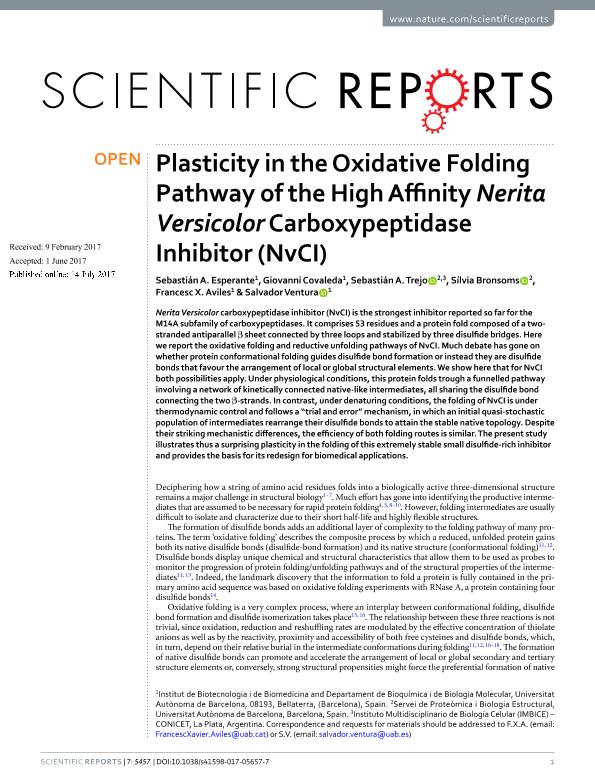Mostrar el registro sencillo del ítem
dc.contributor.author
Esperante, Sebastian

dc.contributor.author
Covaleda, Giovanni
dc.contributor.author
Trejo, Sebastian Alejandro

dc.contributor.author
Bronsoms, Sílvia
dc.contributor.author
Aviles, Francesc X.
dc.contributor.author
Ventura, Salvador
dc.date.available
2018-12-18T20:47:20Z
dc.date.issued
2017-12
dc.identifier.citation
Esperante, Sebastian; Covaleda, Giovanni; Trejo, Sebastian Alejandro; Bronsoms, Sílvia; Aviles, Francesc X.; et al.; Plasticity in the Oxidative Folding Pathway of the High Affinity Nerita Versicolor Carboxypeptidase Inhibitor (NvCI); Nature Publishing Group; Scientific Reports; 7; 1; 12-2017; 1-16
dc.identifier.issn
2045-2322
dc.identifier.uri
http://hdl.handle.net/11336/66711
dc.description.abstract
Nerita Versicolor carboxypeptidase inhibitor (NvCI) is the strongest inhibitor reported so far for the M14A subfamily of carboxypeptidases. It comprises 53 residues and a protein fold composed of a two-stranded antiparallel β sheet connected by three loops and stabilized by three disulfide bridges. Here we report the oxidative folding and reductive unfolding pathways of NvCI. Much debate has gone on whether protein conformational folding guides disulfide bond formation or instead they are disulfide bonds that favour the arrangement of local or global structural elements. We show here that for NvCI both possibilities apply. Under physiological conditions, this protein folds trough a funnelled pathway involving a network of kinetically connected native-like intermediates, all sharing the disulfide bond connecting the two β-strands. In contrast, under denaturing conditions, the folding of NvCI is under thermodynamic control and follows a "trial and error" mechanism, in which an initial quasi-stochastic population of intermediates rearrange their disulfide bonds to attain the stable native topology. Despite their striking mechanistic differences, the efficiency of both folding routes is similar. The present study illustrates thus a surprising plasticity in the folding of this extremely stable small disulfide-rich inhibitor and provides the basis for its redesign for biomedical applications.
dc.format
application/pdf
dc.language.iso
eng
dc.publisher
Nature Publishing Group
dc.rights
info:eu-repo/semantics/openAccess
dc.rights.uri
https://creativecommons.org/licenses/by-nc-sa/2.5/ar/
dc.subject
Plegamiento de Proteinas
dc.subject
Maldi Tof
dc.subject
Inhibidor de Proteasas
dc.subject.classification
Otras Ciencias Biológicas

dc.subject.classification
Ciencias Biológicas

dc.subject.classification
CIENCIAS NATURALES Y EXACTAS

dc.title
Plasticity in the Oxidative Folding Pathway of the High Affinity Nerita Versicolor Carboxypeptidase Inhibitor (NvCI)
dc.type
info:eu-repo/semantics/article
dc.type
info:ar-repo/semantics/artículo
dc.type
info:eu-repo/semantics/publishedVersion
dc.date.updated
2018-10-22T21:50:34Z
dc.journal.volume
7
dc.journal.number
1
dc.journal.pagination
1-16
dc.journal.pais
Reino Unido

dc.journal.ciudad
Londres
dc.description.fil
Fil: Esperante, Sebastian. Universitat Autònoma de Barcelona; España
dc.description.fil
Fil: Covaleda, Giovanni. Universitat Autònoma de Barcelona; España
dc.description.fil
Fil: Trejo, Sebastian Alejandro. Consejo Nacional de Investigaciones Científicas y Técnicas. Centro Científico Tecnológico Conicet - La Plata. Instituto Multidisciplinario de Biología Celular. Provincia de Buenos Aires. Gobernación. Comisión de Investigaciones Científicas. Instituto Multidisciplinario de Biología Celular. Universidad Nacional de La Plata. Instituto Multidisciplinario de Biología Celular; Argentina. Universitat Autònoma de Barcelona; España
dc.description.fil
Fil: Bronsoms, Sílvia. Universitat Autònoma de Barcelona; España
dc.description.fil
Fil: Aviles, Francesc X.. Universitat Autònoma de Barcelona; España
dc.description.fil
Fil: Ventura, Salvador. Universitat Autònoma de Barcelona; España
dc.journal.title
Scientific Reports
dc.relation.alternativeid
info:eu-repo/semantics/altIdentifier/doi/https://dx.doi.org/10.1038/s41598-017-05657-7
dc.relation.alternativeid
info:eu-repo/semantics/altIdentifier/url/https://www.nature.com/articles/s41598-017-05657-7
Archivos asociados
